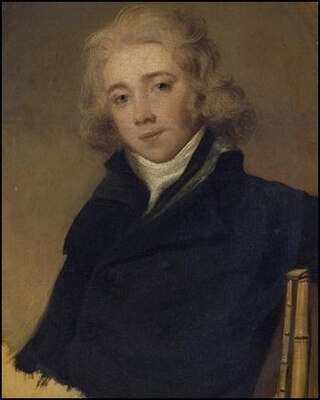
Charles-Valentin Alkan was a French composer and virtuoso pianist. At the height of his fame in the 1830s and 1840s he was, alongside his friends and colleagues Frédéric Chopin and Franz Liszt, among the leading pianists in Paris, a city in which he spent virtually his entire life.

In music, a hundred twenty-eighth note or semihemidemisemiquaver or quasihemidemisemiquaver (British) is a note played for 1⁄128 of the duration of a whole note. It lasts half as long as a sixty-fourth note. It has a total of five flags or beams.
E major is a major scale based on E, consisting of the pitches E, F♯, G♯, A, B, C♯, and D♯. Its key signature has four sharps. Its relative minor is C-sharp minor and its parallel minor is E minor. Its enharmonic equivalent, F-flat major, has six flats and the double-flat B, which makes that key less convenient to use.

The Violin Sonata No. 9 in A major, Op. 47, by Ludwig van Beethoven, is an 1803 sonata for piano and violin notable for its technical difficulty, unusual length, and emotional scope. It is commonly known as the Kreutzer Sonata after the violinist Rodolphe Kreutzer, to whom it was ultimately dedicated, but who thoroughly disliked the piece and refused to play it.

The Cello Sonata No. 3 in A major, Op. 69, is the third of five cello sonatas by Ludwig van Beethoven. He composed it in 1807–08, during his productive middle period. It was first performed in 1809 by cellist Nikolaus Kraft and pianist Dorothea von Ertmann, a student of Beethoven. Published by Breitkopf & Härtel the same year, it was dedicated to Freiherr Ignaz von Gleichenstein, Beethoven's friend and an amateur cellist. The sonata was successful with audiences from the beginning.

The saltarello is a musical dance originally from Italy. The first mention of it is in Add MS 29987, a late-fourteenth- or early fifteenth-century manuscript of Tuscan origin, now in the British Library. It was usually played in a fast triple meter and is named for its peculiar leaping step, after the Italian verb saltare. This characteristic is also the basis of the German name Hoppertanz or Hupfertanz ; other names include the French pas de Brabant and the Spanish alta or alta danza.

Jean-Baptiste Sebastien Bréval was a French cellist and composer. He wrote mostly for his own instrument, including pedagogical works as well as virtuoso display pieces.
Cello Sonatas No. 1 and No. 2, Op. 5, are two sonatas for cello and piano written by Ludwig van Beethoven in 1796, while he was in Berlin. While there, Beethoven met the King of Prussia Friedrich Wilhelm II, an ardent music-lover and keen cellist. Although the sonatas are dedicated to Friedrich Wilhelm II, Ferdinand Ries tells us that Beethoven "played several times at the court, where he also played the two cello sonatas, opus 5, composed for Duport and himself". Although Jean-Pierre Duport was one of the King's teachers, it is now thought to have been his brother Jean-Louis Duport who had the honor of premiering these sonatas.

The Cello Sonata, L. 135, is a sonata for cello and piano by Claude Debussy. It was part of his project Six sonatas for various instruments to compose six sonatas for different instruments. It consists of three movements: Prologue, Sérénade and Finale. It was composed and published in 1915. After performances in London and Geneva in 1916, the sonata's official premiere in Paris was played in 1917 by Joseph Salmon and Debussy. It was the first chamber music work in his late style, and became one of the key works in the repertoire from the 20th century.
Louis-Casimir Escoffier, known primarily as Casimir Ney or L. Casimir-Ney was a French composer and one of the foremost violists of the 19th century.

Hyacinthe Jadin was a French composer who came from a musical family. His uncle Georges Jadin was a composer in Versailles and Paris, along with his father Jean Jadin, who had played bassoon for the French Royal Orchestra. He was one of five musical brothers, the best known of whom was Louis-Emmanuel Jadin.

Grande sonate: Les quatre âges, Op. 33, is a four-movement piano sonata by Charles-Valentin Alkan. The sonata's title refers to the subtitles given to each movement, portraying a man at the ages of 20, 30, 40, and 50. The work was published in 1847, dedicated to the composer's father, Alkan Morhange.
The Violin Sonata No. 1 in G major, Op. 78, "Regensonate", for violin and piano was composed by Johannes Brahms during the summers of 1878 and 1879 in Pörtschach am Wörthersee. It was first performed on 8 November 1879 in Bonn, by the husband and wife Robert Heckmann (violin) and Marie Heckmann-Hertig (piano).
Sonatas, duos and fantasies by Franz Schubert include all works for solo piano by Franz Schubert, except separate dances. They also include a number of works for two players: piano four hands, or piano and a string instrument.
The Symphony for Solo Piano is a large-scale romantic work for piano composed by Charles-Valentin Alkan and published in 1857.

The Cello Sonata No. 2 in C major, Op. 26, No. 2, is a sonata for cello and piano by the Romanian composer George Enescu, written in 1935. A performance lasts about 30 minutes.

Napoléon Alexandre Alkan, born Napoléon Alexandre Morhange, was a French composer and music teacher.
Agnès Vesterman is a French classical cellist.











